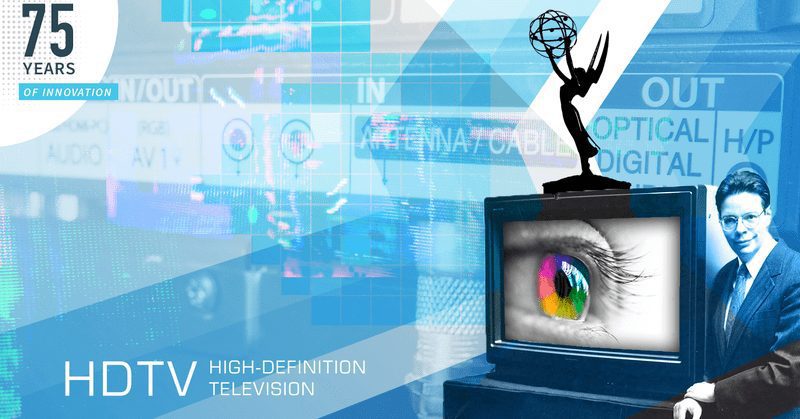The 75 Years of Innovation series highlights the groundbreaking innovations spanning from SRI’s founding in 1946 to today. Each week, SRI will release an innovation, leading up to its 75th anniversary in November 2021.

High-definition TV came out of the early 1990s but continues to captivate and command audiences today
A feast for the eyes: High-Definition Television (HDTV)
High-definition TV came out of the early 1990s but continues to captivate and command audiences today. Sometimes a new development is about more than just a single technological advance. HDTV is a product of a consortium, brought together to solve issues in producing high definition television broadcast and imaging. Sarnoff Laboratories (now a wholly owned subsidiary of SRI International) was part of that consortium, contributing a vital component to the end result to produce a High-Definition Television with commercial potential.
How HDTV came to life in our living rooms
Television has come a long way since the 12-line resolution of the first TV experiments. By the 1950s, the world was witness to TVs that displayed 525 lines of color. As is the want of technology breakthroughs, you often need other technologies to allow a big leap to happen. This was the case for HDTV. In 1979, Japanese TV manufacturers developed a prototype HDTV which allowed some experimental transmissions. Around the same time, Sarnoff Corporation, (ex. RCA and now a subsidiary of SRI), started to research HDTV.
As new advances in TV broadcast came down the line, the standards needed to take HDTV from experiment to production were debated. In 1980, the SMPTE (Society of Motion Picture and Television Engineers) made recommendations on various aspects of HDTV including the wide-screen format of an “1100-line scanning structure”. Great interest in high-definition broadcast and screening resulted in the Federal Communications Commission (FCC) reaching out to the private sector for information and suggestions. From this, an Advisory Committee on Advanced Television Service was set up. One hurdle that was still to be surmounted was the move from Analog to Digital TV. In May 1993, the FCC formed the Digital HDTV Grand Alliance to further develop the U.S. digital television and HDTV specification.
Out of this, a consortium of seven players was formed. The alliance’s goal was to merge four previously competitive digital solutions to collaborate on a best-of-breed approach to HDTV. On March 30, 1995, the fully integrated system, the world’s first digital TV, was ready for demonstration at the Sarnoff field lab.

Four competing digital systems become one HDTV
Each consortium member contributed prototype hardware sub-components to the Grand Alliance HDTV system. The contributors being:
1. AT&T
2. General Instrument
3. MIT
4. Philips
5. Thomson
6. Zenith, and
7. Sarnoff Corporation (now wholly owned by SRI)
The four key competing digital technologies integrated to create the final system were:
- DigiCipher (General Instrument)
- Advanced Digital HDTV (Sarnoff and Phillips)
- Digital Spectrum Compatible HDTV (Zenith and AT&T)
- Channel-Compatible DigiCipher (MIT)
Sarnoff Laboratories, in partnership with Phillips Laboratories, contributed a combined effort known as the Advanced Digital HDTV project. Features of the research included:
- MPEG video and audio compression
- Flexible video formats that provide choices of interlaced or progressive scan with rectangular or square pixels
- Separate video, audio and data packaging that allows a flexible mix of services
- A data format that is well-suited for both broadcast and data networks
- Receivers that disregard unrecognized types of data (removes interference)
- Two separate data carriers with different power levels
- A spectrally shaped signal that avoids NTSC interference (a U.S. standard for older color TV)
- A high 24 Million bits per second total data rate
From vision to reality
In April 1995, the HDTV system developed by the Grand Alliance was integrated at the Sarnoff Field Labs. The HDTV had its world premiere at the NAB 95 show under the banner “From Vision to Reality”.
After the release of the Grand Alliance’s HDTV integrated system, counterclaims by other industry members about potential interoperability issues, arose. The work that Sarnoff Laboratories performed in developing Advanced Digital HDTV specifically resolved many issues on interoperability. In response, Glenn Reitmeier of Sarnoff Labs, spoke to a number of these claims, including satellite and terrestrial broadcast transmission, interlaced and progressive format conversion, and high-speed ATM data networks, showing evidence to refute any interoperability issues.
The Grand Alliance ATSC standard became the world’s first standard for digital television. Most of modern TV, including streaming video, is based on this standard.

A definition of great TV
HDTV has grasped the consumer like no other format. Research from Leichtman Research Group found that over three-quarters of U.S. households own at least one HDTV set.
Watching TV is a shared activity that crosses age boundaries and gives us common talking points. HDTV optimizes that experience, engaging us even more in a world of drama and excitement.
With thanks to Glenn Retmeier website for details
Resources
Leichtman Research Group: https://www.leichtmanresearch.com/author/bruce/
The Dish, 75 Years of Innovation: Liquid Crystal Displays: https://medium.com/dish/75-years-of-innovation-liquid-crystal-displays-805d5afa2d20
75 Years of Innovation: CCD Broadcast Camera: https://medium.com/dish/75-years-of-innovation-ccd-broadcast-camera-61b0920c80db
Federal Communications Commission (FCC): https://www.fcc.gov/document/advisory-committee-advanced-television-service-implementation
First demonstration of HDTV Grand Alliance at Sarnoff Laboratories: https://vimeo.com/402202723
Glenn Reitmeier refutation of interoperability issues: https://vimeo.com/405172836
Glenn Reitmeier blog posts celebrating the 25th year anniversary of the HDTV Grand Alliance: https://www.glennreitmeier.tv/
David Sarnoff Research Center Philips Laboratories Princeton, NJ Briarcliff Manor, NY, Advanced Digital Television, Jan 20, 1992: https://6f3fbc74-3393-4223-93e0-23241dc1b893.filesusr.com/ugd/253fe6_389dee1cd73a4f5c9fa58c3b5d869829.pdf


